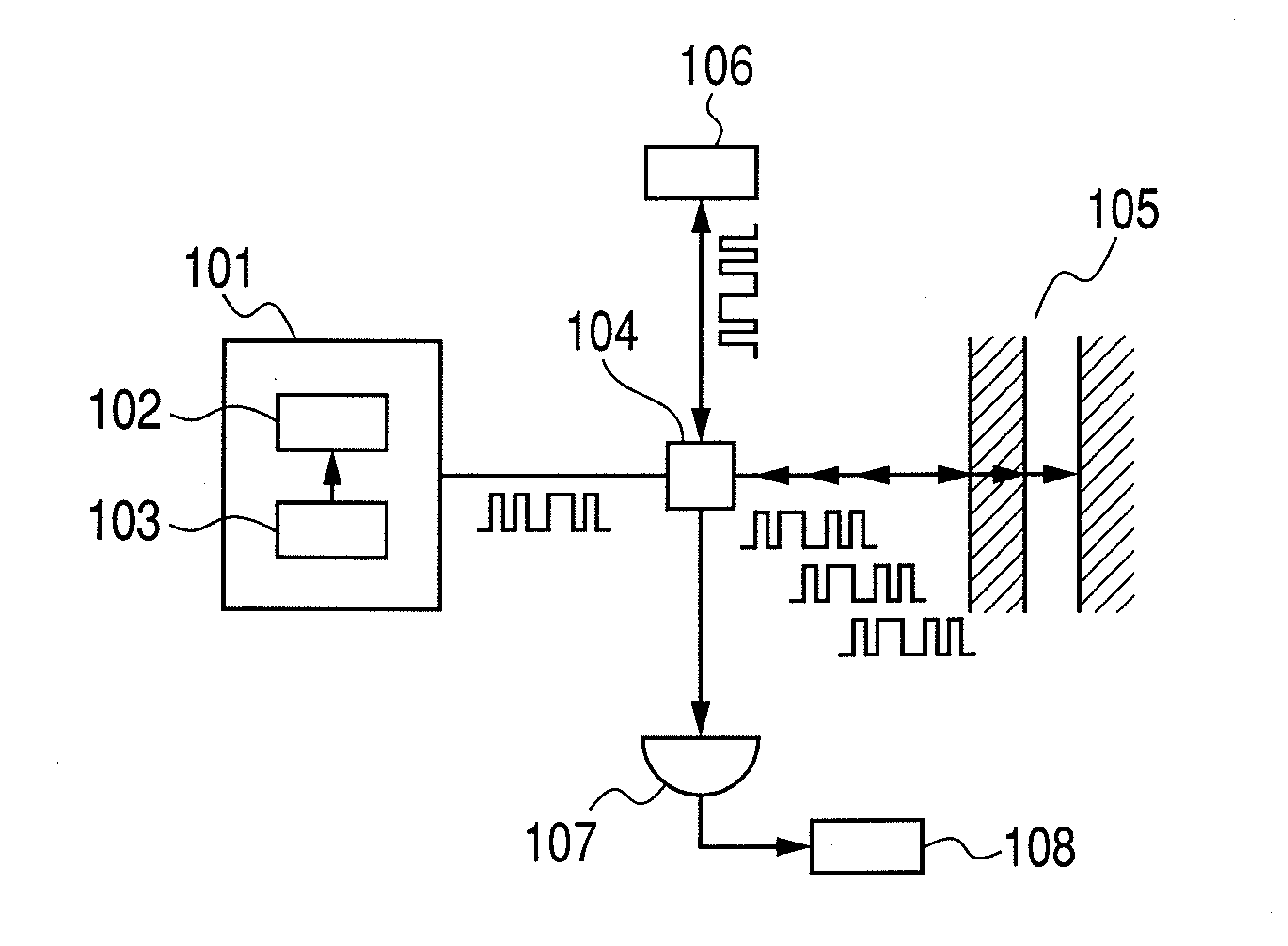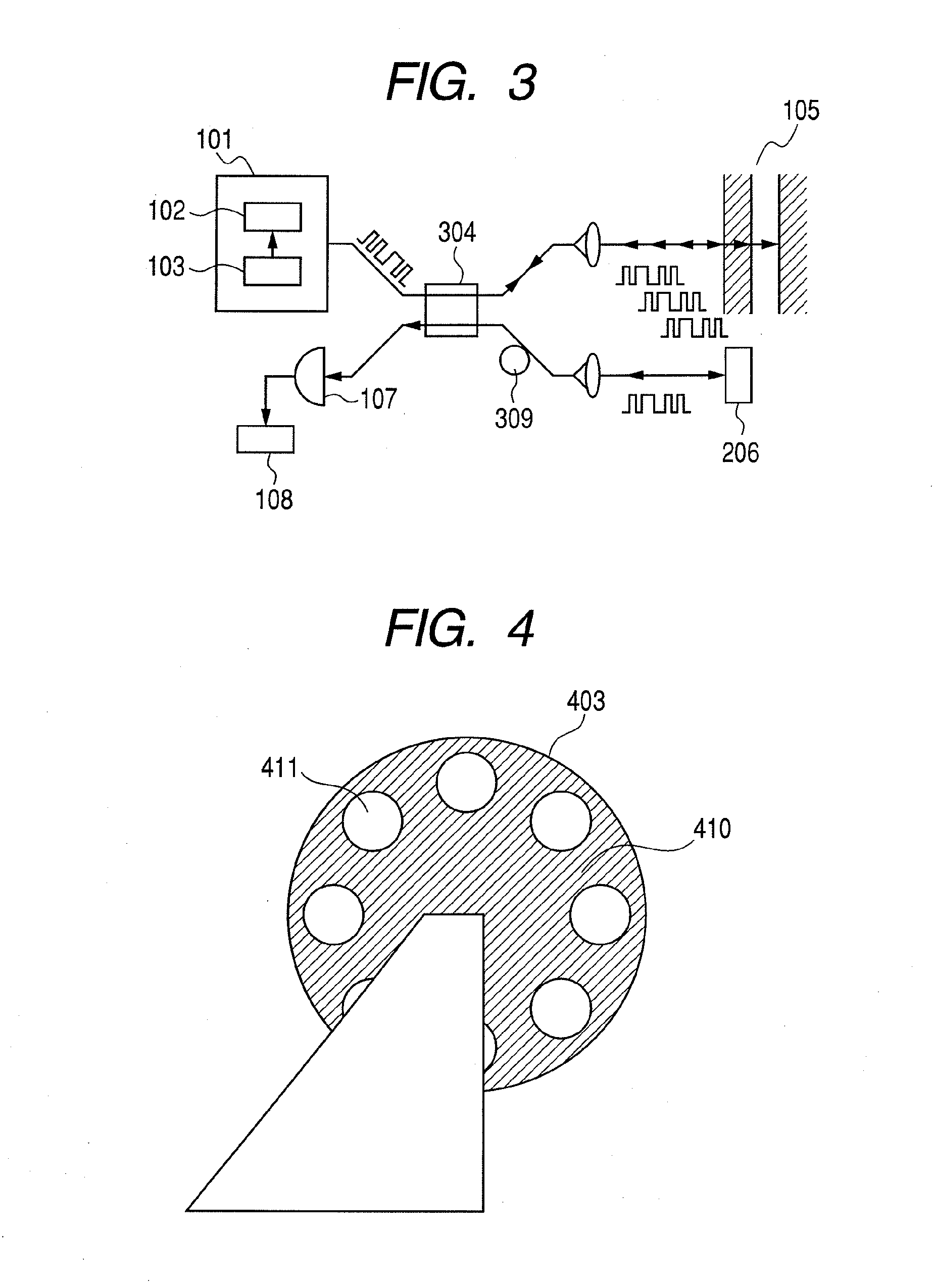Detecting apparatus and imaging apparatus
- Summary
- Abstract
- Description
- Claims
- Application Information
AI Technical Summary
Benefits of technology
Problems solved by technology
Method used
Image
Examples
embodiment 1
[0045]This embodiment relates to a possible configuration for realizing an imaging apparatus according to the present invention. In this embodiment, the present invention is applied to an imaging apparatus for acquiring information on a sample in the depth direction by means of a spatial optical system.
[0046]FIG. 2 is a schematic circuit diagram of the imaging apparatus of this embodiment. In this embodiment, a beam splitter 204 as shown in FIG. 2 is used as coupler section. A reflecting section 206 such as a mirror that optically reflects electromagnetic waves is used as delaying section.
[0047]A quantum cascade laser (QCL) is used for the laser source 102, although some other semiconductor device such as a resonant tunneling diode (RTD) may alternatively be used for the laser source 102. Still alternatively, an oscillator that utilizes a nonlinear optical crystal or an oscillator that utilizes an electron tube such as a backward wave oscillator (BWO) may be used for the laser sourc...
embodiment 2
[0051]This embodiment also relates to a possible configuration for realizing an imaging apparatus according to the present invention. More specifically, the imaging apparatus of this embodiment is obtained by modifying the apparatus of Embodiment 1 by using an optical waveguide for the electromagnetic wave propagation route.
[0052]FIG. 3 is a schematic circuit diagram of the imaging apparatus of this embodiment. As shown in FIG. 3, an optical waveguide 309 of optical fiber is employed for the electromagnetic wave propagation route. A fiber coupler 304 is employed for the coupler section 104 correspondingly.
[0053]With this arrangement, the optical waveguide 309 operates as main electromagnetic wave propagation route. As a result, any possible interferences between the electromagnetic wave and external noises can be reduced to improve the S / N ratio and hence the accuracy of observation. Additionally, this arrangement of using an optical waveguide 309 of optical fiber can simplify the o...
embodiment 3
[0054]This embodiment differs from the above-described embodiments in terms of the method of generating a pseudoincoherent electromagnetic wave by means of the generating section 101. More specifically, an incoherent electromagnetic wave is produced by mechanically sequentially switching the part that transmits an electromagnetic wave and the part that reflects an electromagnetic wave according to a code pattern that changes in time series as described earlier.
[0055]For example, a rotary disk 403 as shown FIG. 4 is employed for the diffusing section 103. Referring to FIG. 4, the rotary disk 403 has reflecting sections 410 that reflect an electromagnetic wave and transmitting sections 411 that transmit an electromagnetic wave. The reflecting sections 410 are typically made of an electro-conductive metal. The transmitting sections 411 may be cavities that may or may not be filled with a substance that is maximally transparent relative to the electromagnetic wave to be transmitted thro...
PUM
 Login to View More
Login to View More Abstract
Description
Claims
Application Information
 Login to View More
Login to View More - R&D
- Intellectual Property
- Life Sciences
- Materials
- Tech Scout
- Unparalleled Data Quality
- Higher Quality Content
- 60% Fewer Hallucinations
Browse by: Latest US Patents, China's latest patents, Technical Efficacy Thesaurus, Application Domain, Technology Topic, Popular Technical Reports.
© 2025 PatSnap. All rights reserved.Legal|Privacy policy|Modern Slavery Act Transparency Statement|Sitemap|About US| Contact US: help@patsnap.com



